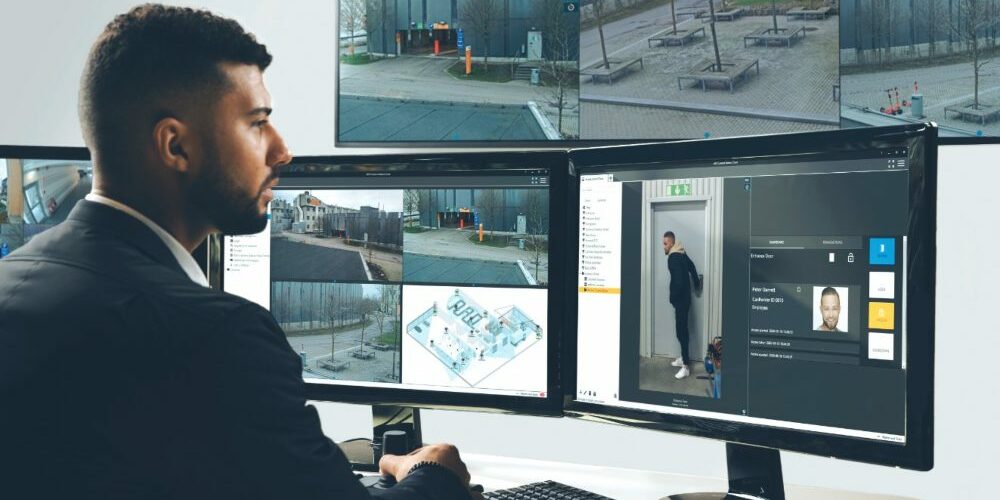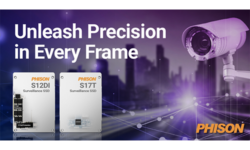Why Cloud, AI Are Set to Dominate Video Surveillance in 2023
Execs from top video surveillance manufacturers opine on biggest trends for 2023, including VMS, Edge computing, VSaaS and more.

VSaaS, Cloud, edge computing, VMS, and AI will all be key driving forces for the continued expansion of video surveillance in 2023. Photo courtesy of Axis Communications.
A layperson with no prior knowledge entering ISC West — the industry’s largest and most influential trade show — might take a look around and assume they entered a camera or surveillance expo. That is how dominant a force video has become in an event — and for the technology and business of security — that not so long ago was primarily intrusion and fire alarm devices and systems. Today, increasingly consumers envision video when considering security; for them it is becoming synonymous.
Hence, security pros who want to get ahead in 2023 had better have a bead on the latest video technology and opportunity trends.
“Cross-functional video use —spanning an end user’s security, safety and business operations — will expand budgets as technology provides greater ROI for companies,” says Scott Dunn, senior director of Business Development Systems & Solutions for Axis Communications. Chuck O’Leary, vice president of sales for Video Systems and Solutions – North America at Bosch Security and Safety Systems, agrees, “The industry will develop a better understanding and appreciation of the power of AI-driven video analytics and its capabilities to strengthen the protection of people and property and to extend video solutions beyond security.”
These experts are among the 10 representatives from six leading security technology vendors who share their takes in SSI’s 2023 Video Surveillance Forecast. Among several areas of focus is the rise in Cloud usage.
“As Cloud-based solutions become more prevalent, we will see greater adoption in sectors including education, healthcare and critical infrastructure,” says Alex Walthers, team lead for Axis’ Technology Integration Partner Program.
Forge ahead for additional keen in-sights on AI, VMS, edge, integration, body cams and more.
2023: AI Advances & Impacts
Quang Trinh, Manager, Professional Services, Axis Communications: Some security systems are still inundated with false positives and nuisance alarms. These challenges can devalue some of the systems that are responsible for safety and security. The move from pixel-based analytics to object-based detection and classification via deep learning will accelerate the precision in which key objects are identified. This advancement will move the security industry from a reactive to a proactive mode.

Quang Trinh of Axis Communications believes the move from pixel-based analytics to object-based detection and classification via deep learning will improve identification capabilities.
Additionally, edge devices running both deep learning [DL] and machine learning [ML] models are able to refine video, acoustic, radar, lidar and other sensor data and provide valuable context to them. As a result, operations like counting, queuing, loitering, and heat mapping will become more refined and the data will have greater accuracy and higher value.
Analytics based on DL and ML will also see improvements in implementation. The technology will be used to assist in deploying and calibrating these devices in a more autonomous way. Systems Integrators who may have struggled in the past to configure and optimize a device with a particular analytic will experience a more seamless process. From the VMS perspective, native analytics on edge devices will distribute the processing away from a central server. This will free up resources that a VMS can utilize while still making use of future-forward edge analytics that device manufacturers bring to the market.
As intelligence is distributed from Cloud, on-premise and edge devices, the security industry will start to see more value in the device data, and especially metadata. In respect to video data, once a DL model is fine tuned to detect humans and vehicles — the two most focused types — other data from the classifications of these objects will allow for more context. Sub-features can be extracted from people and vehicles, and this metadata will usher in new ways to solve a customer’s business use case. Some AI companies are starting to aggregate security system metadata so an operator can easily search for events, people and objects more efficiently than previously possible.
Will Knehr, Senior Manager of Information Security and Data Privacy, iPRO Americas: For systems integrators, the challenge around AI and analytics will continue to be around adding AI, moving back to consultative sales, and providing professional services over the long term, moving away from project-based sales. Successful SIs will embrace AI-enabled analytics and seek all the training opportunities available to become customer subject matter experts. The SI will be challenged by how to choose from the proliferation of options and AI implementation models available, as no provider can be an expert at all. Open strategy partners may emerge as the preferred choice with easily integrated plug-and-play analytics models.
2023: Cloud & VSaaS Dynamics
Chuck O’Leary, V.P. Sales, Video Systems and Solutions – North America, Bosch Security and Safety Systems: The pandemic increased the need for remote access to information, and as a result, users have become more comfortable with Cloud-based services in general. This is having a positive impact on the adoption of Cloud video. As end users understand that they can replicate in the Cloud what they currently do on premise, growth will continue in 2023.

Chuck O’Leary of Bosch believes VSaaS with AI alarm verification offers improved results and greater financial flexibility.
Video security as a service [VSaaS] will also benefit from AI in 2023, specifically in the form of AI-based alarm verification. This type of service can help filter unwanted alerts for operators — only detecting true events. For example, an animal detected by the camera along-side a perimeter is a valid alert, but unimportant for perimeter security. An AI-based alarm verification service will filter such unwanted alerts. The advantages of such a service are minimizing false alarms, reducing costs and strengthening the reliability of the security application. It makes it possible to tailor alerts to a customer’s needs, filtering unwanted alarms, increasing efficiency, and minimizing costs.
VSaaS also provides greater financial flexibility for end users, offering the ability to tap into both a capital budget, for the cameras, as well as an operational budget, for the service. This flexibility may be attractive to some end users — especially those with a large upgrade to perform, as it reduces the upfront investment.
Hamish Dobson, V.P., Product Management, Video Security & Access Control, Motorola Solutions: VSaaS providers can be expected to grow their offering by adding more form factors to their camera portfolios and additional capabilities to address more com-plex customer needs. With data intelligence becoming a more relevant focus we will likely see an expansion of applications delivered via Cloud services as part of broader VSaaS. Market verticals in which end users want to reduce their hardware footprint and manage their video systems in a centralized and scalable manner will continue to be the key driver. Some segments will see slower adoption due to regulatory barriers.
Data protection requirements are a key aspect affecting Cloud-based video security. In some jurisdictions, as well as specific verticals, data has to stay within the region or country, creating a challenge for vendors that rely upon central Cloud services providers. This may mean that some regions are going to have fewer VSaaS solutions competing in their juris-dictions.
Kyle Heironimus, V.P. of Advanced Product, DMP: This is the way of nearly every industry and will continue. There are too many systems locked in a closet that no one ever touches. Once people see the bene-fits of Cloud video and security that they can interact with and that provides value to them, they will gladly pay recurring amounts and drop the old systems.
2023: Expanding Edge Computing
Will Knehr, iPRO Americas: In terms of AI-enabled cameras as IoT devices, processing metadata on edge will continue to grow and become the norm with surveillance cameras. The edge is going to get increasingly more powerful and will lead to containerization. Finding ways to optimize IoT technologies better will be the key to future networks.

i-PRO’s Will Knehr believes one reason cloud surveillance will continue to thrive is the trend toward smaller devices, which limits storage capacity and processing power.
Due to the limitations of IoT hardware — mostly stemming from cost and the small form factor that limits processors, memory, drives, graphic cards and cooling — the industry will need to embrace containers to move more AI to the edge. Simply put, containers are just virtual environments that software can run in-side. Since the container is virtual, the processing can be done by several devices. Docker containerization introduces the
concept of the IoT network as a brain that becomes capable of doing all the processing needed.
Kubernetes can manage this network of small computers that can process whatever is required — essentially a virtual computing resource bed that can shift resources dynamically. For example, by shifting some processing from a busy IoT device to an IoT device in a back room where there is not much activity and it is often not actively processing, Kubernetes can load-manage to do more processing. In contrast, an IOT device in a busier area that is actively watching can focus only on that. Containerization is the future of edge computing.
2023: VMS Capabilities Grow
Laurent Villeneuve, Product Marketing Manager, Video & Appliances, Genetec: A growing requirement for security operations is to be able to better collaborate and communicate among internal teams, locations and with external stakeholders. We see 2023 as a big year for this, where end users will try to centralize communication and data exchange tools. Video management systems are the cornerstone of an effective collaboration system, and where communications should be built into every task and workflow.

Laruent Villenueve from Genetec believes a big trend in 2023 will be the need for better collaboration and communication among members of security teams.
An intercom can be just as crucial as a camera for incident response or day-to-day monitoring operations. Tying it with maps, video recordings, access control events, and other datapoints enhances efficiency and response time. Advances in the unification of communications with VMS, along with improvements in mobility — for example sharing data and performing video calls from the operations center to mobile phones — will empower security teams across most industries in 2023.
As we deploy VMS solutions and move toward hybrid architectures, it will be important to leverage existing investments in edge devices without overloading the security and IT infrastructure. One of the challenges will be to carefully design solutions that optimize bandwidth, get the maximum out of security appliances and don’t compromise privacy. It will be very important that we guide customers in choosing the right sensors, installing them properly and implementing smart VMS capabilities to bring it all together.
2023: Video Integration Increasing
Hamish Dobson, Motorola Solutions: The unification of video security and access control is well established in the market. Fundamental differences primarily exist in the depth and intuitiveness of unified offerings. We have seen great advancements in video AI capabilities and data intelligence. We can certainly expect that optimizing alerting, verification and incident management will be a strong focus across video and access control systems. Further to this, intrusion alerting is a sub-layer on this event matrix.

Hamish Dobson of Motorola Solutions says data protection for Cloud-based surveillance is vital.
Integrations with access control and intrusion detection solutions are no longer a nice-to-have, they are expected by customers. Traditionally, this meant basic alarm management and event verification. However, the market is heading in a direction where unified incident and identity management are becoming corner-stones of a great user experience. We can expect this trend not to remain limited to access control and intrusion, rather it will also include a much wider range of IoT-based sensor solutions.
Kyle Heironimus, DMP: DMP will soon be introducing products that take advanced video analytics technology and combine it with the information from a security and access control system to provide real value and security. Standard video systems show you what happened after the fact. Analytics add-ons tell you when someone is seen but doesn’t always know if you care. Security systems use low-tech sensors to detect possible intrusions, but don’t leverage the advanced video technologies available.
Combining the three gives customers a major leap forward in security by using video devices and analytics as detectors for the security system, which knows when a person should or should not be in a particular area. By integrating these technologies, we will see more focus on providing actual value rather than just providing video or analytics to check off a box on the spec.
Chuck O’Leary, Bosch: While standards like ONVIF have helped to make integration easier for some technologies and provided integrators with more options, a system that involves intrusion and access control from one manufacturer, cameras from another and a VMS from a third puts the integrator in the middle. If part of the integration does not work correctly, the integrator may have to troubleshoot with multiple manufacturers to fix the issue, which can require additional time and energy and add expense to the project. Or the integration may not include all the available features of the individual technology components — limiting capabilities.
It is important to fully research integration claims to ensure the final solution will fit what the end user requires. In some instances, using multiple manufacturers may be required by the user or specifier or there may be an existing video, access control, or intrusion system already in place. If this is the case, partnerships that exist between some manufacturers may help to ensure a smoother integration.
2023: Body-Worn Use Upswing
Steve Jussaume, Solutions Engineer, Axis Communications: The more significant advances and impacts in the body-worn camera [BWC] space will be tied to connectivity and situation awareness. The use of BWCs continues to grow and expand beyond law enforcement, as more users want the ability to monitor their operators in the field. A BWC that can connect to a net-work and stream video and audio back to a SOC allows administrators to be aware of when a camera has been activated, so they can log into it and view what is happening.

Steen Jussaume of Axis Communications forecasts a jump in demand for body-worn surveillance cameras in 2023.
Having access to this information, means that administrators can make critical decisions on how to respond to any incidents without having to be on scene or wait for the person to feed information back to the security operations center. This need is rising in many industry segments such as retail and healthcare. Situational awareness does not just mean video, it can also be provided via data — meaning that information can be provided through a BWC’s location or other triggering mechanisms.
If you enjoyed this article and want to receive more valuable industry content like this, click here to sign up for our FREE digital newsletters!

Security Is Our Business, Too
For professionals who recommend, buy and install all types of electronic security equipment, a free subscription to Commercial Integrator + Security Sales & Integration is like having a consultant on call. You’ll find an ideal balance of technology and business coverage, with installation tips and techniques for products and updates on how to add to your bottom line.
A FREE subscription to the top resource for security and integration industry will prove to be invaluable.








